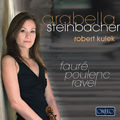ORFEO International – Reviews
Important Releases Briefly Introduced
June 2008
ORFEO 1 CD C 739 081 A
French 
Arabella Steinbacher
Foto: Henry Fairchamber music from the time of the Third Republic is remarkable for its tremendous stylistic variety, revealing, as it does, not only Neoclassical elements but also unexpected rhythms, the sort of local colour associated with folk music and, last but not least, typically French melodies typified by their elegance and songlike character. A classic and, indeed, prototypical example of this style is Fauré’s Violin Sonata op. 13 first performed in 1877 and now at the very heart of the new CD that Arabella Steinbacher has recorded with the pianist Robert Kulek. Inspired by the Belgian violinist Hubert Léonard, Fauré’s Violin Sonata offers Arabella Steinbacher ample opportunity to brighten her tone in a veritable floodtide of melody, while allowing cascades of notes to rain down in ensemble playing with Robert Kulek that could hardly be more subtly differentiated from a dynamic point of view. 
C 739 081 AWritten half a century later, Ravel’s Violin Sonata not only places considerable technical demands on its performers, it also reflects the influence of jazz, an influence explored by the two performers with audible delight in imitating plucked instruments and blue notes. And the dizzying energy generated by Arabella Steinbacher and her accompanist in Ravel’s Tzigane needs to be heard to be believed. All that can be added here is that this homogeneous and yet varied programme opens with a piece that may also be regarded as an epilogue to this chapter from the history of French music: Francis Poulenc’s Violin Sonata was written in the 1940s in memory of Federico García Lorca and is a tremendously compact work in terms of its expressive and compositional density. Arabella Steinbacher and Robert Kulek bring to it all the necessary shades and nuances.
top |